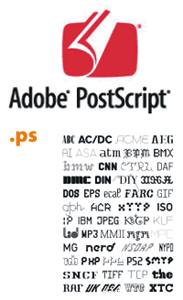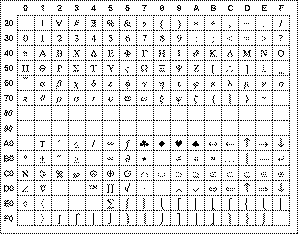 • Consider the Beauty of PostScript®
• Consider the Beauty of PostScript®
Adobe’s PostScript® page-description language (PDL) may be an esoteric execution for geeks, but it is both a work of genius and a thing of beauty. The PostScript language describes every element on a printable page in both mathematical and programmatic terms. This has huge advantages for output and transportability. For one thing, it enables graphical elements of the page, such as logos, to be defined with absolute, mathematical precision as vectors.
![]() A pioneering presence in the world of desktop/digital publishing. PostScript was one of the earliest results of the entrepreneurial partnership of John Warnock and Charles Geschke, Adobe Corporation. In 1985, this tiny, new enterprise launched the first version of Adobe Illustrator® to enable encapsulated versions of PostScript — EPS (Encapsulated PostScript) files — to be created and incorporated into the new technologies of a desktop-publishing workflow. Indeed, the two products were at the heart of this new publishing revolution.
A pioneering presence in the world of desktop/digital publishing. PostScript was one of the earliest results of the entrepreneurial partnership of John Warnock and Charles Geschke, Adobe Corporation. In 1985, this tiny, new enterprise launched the first version of Adobe Illustrator® to enable encapsulated versions of PostScript — EPS (Encapsulated PostScript) files — to be created and incorporated into the new technologies of a desktop-publishing workflow. Indeed, the two products were at the heart of this new publishing revolution.
 With PostScript at its underlying foundation, the very shape of the objects and those that form the letters comprising text on the page can also be described as precisely defined outlines. This mathematical approach means that PostScript "Type 1" fonts are infinitely scalable so that PostScript-based printers and imagesetters could suddenly specify any of the included typefaces (Times, Helvetica, Courier and Symbol) at any size. The very Bezier® countours that proved so innovative in Illustrator is also a distinguishing core element in PostScript’s PDL.
With PostScript at its underlying foundation, the very shape of the objects and those that form the letters comprising text on the page can also be described as precisely defined outlines. This mathematical approach means that PostScript "Type 1" fonts are infinitely scalable so that PostScript-based printers and imagesetters could suddenly specify any of the included typefaces (Times, Helvetica, Courier and Symbol) at any size. The very Bezier® countours that proved so innovative in Illustrator is also a distinguishing core element in PostScript’s PDL.
Such infinite scalability permits output that conforms to the resolution of the output device. The resulting page generated in this manner cannot pixelate because its output is a function of mathematical dimensioning. In fact, it will not undergo resterization unless and until it is received by the output device — such as a printer — at the size and resolution specified by the device.
Genuine Adobe PostScript (even most of its more generic, derivative interpreters, such as Phoenix® and HP’s reverse-engineered imitation) yield this precision and clarity of output.
![]() PostScript is the underpinning and parent of the now-more-familiar Portable Document Format, better known as PDF. A PDF document distilled from the original live text file provides a good case in point. Not only is the text in such a PDF file selectable, but if you magnify it to even 1600% of actual size, the type not only remains live, editable text, but is also just as sharp and well formed as at any lesser degree of enlargement.
PostScript is the underpinning and parent of the now-more-familiar Portable Document Format, better known as PDF. A PDF document distilled from the original live text file provides a good case in point. Not only is the text in such a PDF file selectable, but if you magnify it to even 1600% of actual size, the type not only remains live, editable text, but is also just as sharp and well formed as at any lesser degree of enlargement.
The current version of Adobe Illustrator can produce EPS files that open perfectly as PDF; just change the extension of the filename from ".eps" to ".pdf" and it will summarily launch in Adobe Acrobat. (This is not true of versions prior to Illustrator 10, however; the two products were at different stages of development and their differentiation was more distinct and less interchangeable.)
PostScript, but to keep it from becoming a forgotten form. One of the best online educators and trainers in PostScript and its related forms is John Deubert. His current company is Acumen Training, but his experience in all things PostScript goes back to its origins. In 1984 John joined the startup Adobe Systems. As a customer-support engineer, John wrote the PostScript Language Tutorial, the front half of Adobe’s standard Blue Book. He also put together Adobe’s first classes in PostScript, teaching small groups from Adobe OEMs as they signed up for their first PostScript printers. (Remember the first Apple® LaserWriter?® A $7,000 Level 1 PostScript printer — broke new ground when released in 1986.)
Deubert left Adobe Systems in 1985 to start a software company in San Diego, California — Acquired Knowledge — and developed a number of software production tools there, in addition to teaching PostScript. During this time, he continued working for Adobe as a consultant, doing programming and course development. His expertise and passion for the technology will help others maintain the necessary appreciation of this key technology in publishing circles, even as awareness of it dwindles in the consumer market.
.........TOP OF PAGE
